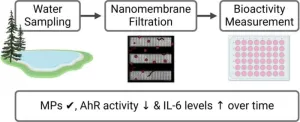(Press-News.org) A new USC study suggests that publicly insured individuals who are most likely to benefit from new drugs for diabetes and obesity are less likely to get them than those with private insurance.
Prescription fills for the drug best known as Ozempic or Wegovy — semaglutide — increased by more than 400% between January 2021 and December 2023, according to research out today in JAMA Health Forum.
Approved first for type 2 diabetes, then for weight loss, studies show that semaglutide also improves blood pressure and reduces cardiovascular disease — problems that plague millions of Americans. Yet the lion’s share of prescriptions went to people with private insurance.
“Given the proven cardiovascular benefits of Ozempic and Wegovy when used for diabetes or obesity, and the disproportionate burden of diabetes and obesity in Black/Latinx Medicaid and Part D populations, these findings suggest that their lower use in Medicaid and Part D may worsen disparities in diabetes and obesity outcomes,” said senior author Dima Qato, an associate professor at the USC Mann School of Pharmacy & Pharmaceutical Sciences and senior scholar at the USC Leonard D. Schaeffer Center for Health Policy & Economics.
“I think all the current attention in the media on semaglutide's anti-obesity effect obscures the fact that the drug is also hugely important for treating diabetes. It’s the reason why I’ve been able to get some of my patients off insulin,” said first author Christopher Scannell, a physician and postdoctoral researcher at the Schaeffer Center. “If only certain patient populations get access to these medications — those primarily with private insurance, more generous health plans — then there’s a huge percentage of the U.S. population that isn’t getting access to these medications. And that brings up a very significant equity issue.”
Ozempic and Wegovy are once-weekly injections. Another form of semaglutide, Rybelsus, is a daily pill. Ozempic was approved in 2017, followed by Rybelsus in 2019, to treat type 2 diabetes. Wegovy, approved 2021, is a higher-dose version that’s specifically approved for weight loss. Ozempic’s sticker price is about $1,000 per month, while Wegovy is listed around $1,350.
For the study, researchers used data from IQVIA’s National Prescription Audit PayerTrak, which captures 92% of prescriptions filled and dispensed to individuals at retail pharmacies in the United States.
Then, they calculated monthly fills for semaglutide by drug brand (Ozempic, Wegovy, and Rybelsus) and by payment method (commercial insurance, Medicaid, Medicare Part D, and cash) between January 2021 and December 2023.
Prescription fills reached 2.6 million by December 2023. Ozempic persistently accounted for most of the prescriptions, but prescription fills for Wegovy, approved for weight loss in June 2021, soared by more than 1,361% between July 2021 and December 2023. Awareness of the drugs’ weight-loss benefits shot up in late 2022 and likely contributed to shortages of Ozempic and Wegovy, first reported by the FDA in March 2022.
Medicaid accounted for less than 10% of semaglutide fills for all three drug brands in 2023. Access via Medicaid is a state-level decision, Scannell said. Depending on the budget — and politics — of where you live, the drugs may or may not be covered. (Medicaid provides assistance to low-income people, the elderly and some people with disabilities.)
Medicare Part D accounted for 28.5% and 32.9% of Ozempic and Rybelsus fills, respectively, in 2023; it only accounted for 1.2% of Wegovy fills. Medicare Part D doesn’t cover the drugs for obesity unless a patient also has a co-morbidity such as cardiovascular disease as well — the very problem Wegovy or Ozempic can prevent.
Approximately 1% or less of all semaglutide fills went to people paying cash in 2023.
In the context of treating obesity, Scannell said, “if Medicare is only covering these drugs for patients who have obesity and a co-morbidity, it may be forcing patients who only have obesity to develop these additional chronic conditions before they can get access to the medications. It’s like saying ‘You have to be sick enough, then we’ll cover that medication for you.’”
The researchers said future studies should examine how changes in Medicare Part D and Medicaid coverage restrictions influence disparities in access to these essential medications. In addition, further research could examine individual-level variables such as age, race, and ethnicity and whether the drugs were prescribed for obesity or diabetes.
In addition to Scannell and Qato, other authors include John Romley, Rebecca Myerson and Dana Goldman, all of USC.
END
Exploding popularity of Ozempic and Wegovy among privately insured patients may worsen disparities
A USC study of prescription data shows that people with Medicaid or Medicare Part D may be missing out on powerful new obesity and diabetes drugs
2024-08-02
ELSE PRESS RELEASES FROM THIS DATE:
Sizing up microplastics: Nanofiltration uncovers environmental bioactivity
2024-08-02
A new study reveals the bioactivity of microplastics in Lake Ontario using cutting-edge nanomembrane filtering technology. Researchers found all samples contained microplastics ranging between 8 and 20 µm. The study highlights varying bioactivity levels, such as aryl hydrocarbon receptor (AhR) activity and IL-6 levels, indicating potential health risks. These findings underscore the urgent need for further research to comprehend the impact of microplastics on human health and the environment. This pioneering approach offers fresh insights into tackling the challenges posed by microplastic pollution.
Microplastics ...
What gave the first molecules their stability?
2024-08-02
The origins of life remain a major mystery. How were complex molecules able to form and remain intact for prolonged periods without disintegrating? A team at ORIGINS, a Munich-based Cluster of Excellence, has demonstrated a mechanism that could have enabled the first RNA molecules to stabilize in the primordial soup. When two RNA strands combine, their stability and lifespan increase significantly.
In all likelihood, life on Earth began in water, perhaps in a tide pool that was cut off from seawater at low tide but flooded by waves at high tide. Over billions of years, complex molecules like DNA, RNA and proteins ...
Cold antimatter for quantum state-resolved precision measurements
2024-08-02
Why does the universe contain matter and (virtually) no antimatter? The BASE international research collaboration at the European Organisation for Nuclear Research (CERN) in Geneva, headed by Professor Dr Stefan Ulmer from Heinrich Heine University Düsseldorf (HHU), has achieved an experimental breakthrough in this context. It can contribute to measuring the mass and magnetic moment of antiprotons more precisely than ever before – and thus identify possible matter-antimatter asymmetries. BASE has developed a trap, which can cool individual antiprotons much more rapidly ...
Smart aggregates: The future of infrastructure health monitoring
2024-08-02
The proliferation of concrete infrastructure worldwide has been met with growing concerns over its durability and safety. Concrete structures are increasingly subjected to dynamic forces from natural disasters like earthquakes and environmental degradation, such as corrosion. These factors, coupled with the saturation of infrastructure projects, amplify the risks associated with structural failure. Consequently, there is a pressing need for effective structural health monitoring (SHM) systems that can preemptively identify and address these vulnerabilities. The ...
Synthesis of SiOC@C ceramic nanospheres with tunable electromagnetic wave absorption performance
2024-08-02
In recent years, microwave technology has dramatically progressed, marked by the arrival of the 5G era, owing to the advantages of electromagnetic waves in long-distance, wireless, and high-speed transmissions. However, electromagnetic wave pollution problems such as electromagnetic wave interference and electromagnetic wave radiation are becoming increasingly serious. Electromagnetic wave pollution not only affects the normal operation of electronic equipment, greatly threatens the information security of the scientific community, but also endangers human health and is a possible cause of cancer ...
NWSL add lifesavers to the chain of survival in New York City
2024-08-02
NEW YORK CITY, August 2, 2024 — According to American Heart Association data, nine out of every ten people who experience cardiac arrest outside of a hospital die, in part because they do not receive immediate CPR more than half of the time. CPR, especially if performed immediately, can double or triple a person’s chance of survival. That is why the American Heart Association and the National Women’s Soccer League (NWSL) brought cardiopulmonary resuscitation (CPR) and automated external defibrillator (AED) training to NWSL staff at the New York headquarters office located on Madison ...
Solving the doping problem: Enhancing performance in Organic Semiconductors
2024-08-02
Cavendish physicists have discovered two new ways to improve organic semiconductors. They found a way to remove more electrons from the material than previously possible and used unexpected properties in an environment known as the non-equilibrium state, boosting its performance for use in electronic devices.
“We really wanted to hit the nail and figure out what is happening when you heavily dope polymer semiconductors,’ said Dr Dionisius Tjhe, Postdoctoral Research Associate at the Cavendish Laboratory. Doping is the process of removing or adding electrons into a semiconductor, increasing its ability to ...
More pets relinquished to shelters due to housing insecurity
2024-08-02
Housing policies may be becoming more pet inclusive, but housing insecurity is getting worse, finds a new study that examined the housing issues that led to owners turning their pets over to an animal shelter.
“Over the duration of the study, instances of animals entering shelters due to loss of housing rose, while those due to pet restrictions and landlord conflicts declined,” said the study’s lead author Jennifer Applebaum, Ph.D., an assistant professor in the Department of Environmental and Global Health in the University ...
KTU researchers’ eye-tracking study provides valuable insights into learning mathematics
2024-08-02
Eye-tracking allows studying aspects that cannot be seen, for example, the thinking processes of a student solving a mathematical problem. Researchers at Kaunas University of Technology (KTU) are the first in Lithuania to integrate eye-tracking into education and are using the technology to radically improve the teaching of mathematics.
Eye-tracking creates the possibility for researchers to observe a subject’s attention shifts based on where they fix their gaze or how they move it. This helps researchers understand various emotional, thinking and cognitive processes that happen in response to the environment.
“By applying this technology in mathematical education, ...
New approaches and insights on the environment and climate change at the 37th International Geological Congress 2024
2024-08-02
□ Overview
○ Event: The 37th International Geological Congress 2024 (IGC 2024)
○ Date/Venue:: 25 Aug (Sun) - 31 Aug (Sat) 2024, 7 days / BEXCO, Busan, Republic of Korea ※ Hosted in a 4-year cycle across continents
○ Scale: Over 7,000 participants from 121 countries (more than 3,000 scientipic programs, 250 exhibition booths)
○ Theme: The Great Travelers: Voyages to the Unifying Earth
○ Host: International Union of Geologcial Sciences (IUGS)
○ Organizer: IGC 2024 Organizing Committee (The Geological Society Of Korea, Korea Institute of Geoscience and Mineral Resources, Busan Metropolitan ...
LAST 30 PRESS RELEASES:
Heart-brain connection: international study reveals the role of the vagus nerve in keeping the heart young
Researchers identify Rb1 as a predictive biomarker for a new therapeutic strategy in some breast cancers
Survey reveals ethical gaps slowing AI adoption in pediatric surgery
Stimulant ADHD medications work differently than thought
AI overestimates how smart people are, according to HSE economists
HSE researchers create genome-wide map of quadruplexes
Scientists boost cell "powerhouses" to burn more calories
Automatic label checking: The missing step in making reliable medical AI
Low daily alcohol intake linked to 50% heightened mouth cancer risk in India
American Meteorological Society announces Rick Spinrad as 2026 President-Elect
Biomass-based carbon capture spotlighted in newly released global climate webinar recording
Illuminating invisible nano pollutants: advanced bioimaging tracks the full journey of emerging nanoscale contaminants in living systems
How does age affect recovery from spinal cord injury?
Novel AI tool offers prognosis for patients with head and neck cancer
Fathers’ microplastic exposure tied to their children’s metabolic problems
Research validates laboratory model for studying high-grade serous ovarian cancer
SIR 2026 delivers transformative breakthroughs in minimally invasive medicine to improve patient care
Stem Cell Reports most downloaded papers of 2025 highlight the breadth and impact of stem cell research
Oxford-led study estimates NHS spends around 3% of its primary and secondary care budget on the health impacts of heat and cold in England
A researcher’s long quest leads to a smart composite breakthrough
Urban wild bees act as “microbial sensors” of city health.
New study finds where you live affects recovery after a hip fracture
Forecasting the impact of fully automated vehicle adoption on US road traffic injuries
Alcohol-related hospitalizations from 2016 to 2022
Semaglutide and hospitalizations in patients with obesity and established cardiovascular disease
Researchers ‘listen in’ to embryo-mother interactions during implantation using a culture system replicating the womb lining
How changing your diet could help save the world
How to make AI truly scalable and reliable for real-time traffic assignment?
Beyond fragmented markets: A new framework for efficient and stable ride-pooling
Can shape priors make road perception more reliable for autonomous driving?
[Press-News.org] Exploding popularity of Ozempic and Wegovy among privately insured patients may worsen disparitiesA USC study of prescription data shows that people with Medicaid or Medicare Part D may be missing out on powerful new obesity and diabetes drugs





